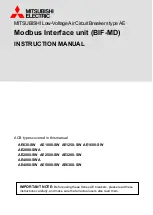
Instruction Book
Page 34
Effective: February 2007
For more information visit: www.EatonElectrical.com
I.B. 8295A61H07
SECTION 6: BREAKER ELEMENT
INTERFACING
6-1 INTRODUCTION
WARNING
•
THE CUSTOMER SHOULD READ AND UNDER-
STAND THE WARNINGS PRESENTED ON THE
FRONT COVER AND IN SECTION 1 OF THIS
INSTRUCTION BOOK BEFORE ANY ATTEMPT IS
MADE TO ALTER, ADD TO OR INTERFACE WITH
THE BREAKER ELEMENT AS SUPPLIED BY
CUTLER-HAMMER.
•
IT IS IMPERATIVE THAT ANSI STANDARD C37.59
BE COMPLIED WITH IN EVERY RESPECT AND
THAT NO COMPROMISES ARE MADE WITH
RESPECT TO ITS GUIDELINES OR INTENT.
•
ADDITIONS TO THE BREAKER ELEMENTS AS
SUPPLIED BY CUTLER-HAMMER CAN BE MADE
IN KEEPING WITH ANSI STANDARD C37.59 AND
THE INSTRUCTIONS PRESENTED IN THIS
INSTRUCTION BOOK. UNDER NO
CIRCUMSTANCES, HOWEVER, SHOULD
ALTERATIONS TO THE CUTLER-HAMMER
SUPPLIED BREAKER ELEMENT BE MADE
UNLESS THE ALTERATION IS SPECIFICALLY
ADDRESSED AND PERMITTED BY THIS
INSTRUCTION BOOK.
6-2 GENERAL GUIDELINES
This section addresses interfacing guidelines for the
Series 18, Series 20 and Series 29 VCP-WR breaker
elements. General guidelines applicable to all three
breaker elements are presented first. Specific guidelines
for each individual breaker element are presented after
the general guidelines. Read, understand and follow the
general guidelines first followed by the guidelines for the
specific series of breaker element purchased.
6-2.1 ELECTRICAL CLEARANCES
It is the responsibility of the customer to insure that the
proper electrical clearances are maintained on the
circuit breaker, in the assembly structure and between
the circuit breaker and its assembly structure. These
required electrical clearances must be in keeping with
the appropriate ANSI standard and the specific BIL level
of application. The BIL Rating associated with a
particular breaker element is clearly indicated on the
breaker’s nameplate located on the front cover.
6-2.2 INTERPHASE BARRIERS
ANSI standards require specific minimum air space
clearances between poles for specific BIL application
levels. It is the customer’s responsibility to insure that
proper interphase barriers are in place on all circuit
breakers prior to inserting a circuit breaker into a cell
and/or placing a circuit breaker in service.
Interphase barriers must be designed to fulfill the ANSI
requirements. They must be constructed of an
appropriate insulating material, such as a one eighth
inch thick high strength, track resistant glass-mat
polyester.
6-2.3 FRONT COVER (FACEPLATE)
All VCP-WR breaker elements are supplied with a front
cover faceplate already installed (Figures
3-1, 3-3,
and
3-5
)
.
The front cover is constructed of a heavy gauge
steel and solidly attached to the breaker element. The
front cover, as supplied, prevents front access to the
breaker mechanism and primary voltage parts. A
breaker specific nameplate and operational windows are
also a part of the front cover (Figure
3-7
).
If a new front cover must be constructed for a specific
circuit breaker design or application, all of the above
mentioned features of the original faceplate must be
carried over to the new faceplate. The new faceplate
must reflect the following as a minimum (Figure
6-1
):
•
A front cover should clearly indicate all of the
information presented on the original nameplate.
•
A front cover should prevent front access to the
breaker’s operating mechanism and any primary volt-
age parts once the breaker is installed.
•
A front cover should include properly placed and sized
windows so that operational indicators, such as main
contact status and closing spring status, are clearly
visible.
•
A front cover should include properly placed and sized
windows for access to breaker operating devices,
such as manual open/close buttons and the manual
charging socket.
Summary of Contents for Cutler-Hammer 150 VCP-WR 1500
Page 2: ......














































